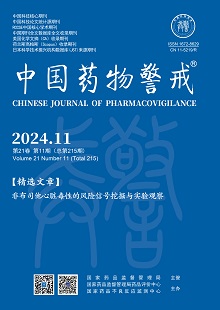|
|
Lujiao Formula Inhibiting Cardiac Hypertrophy Induced by Ang Ⅱ through Regulating the NF-κB Pathways
ZHANG Jianwei, LIU Li, XU Guanglin, SHI Xiaoli
2024, 21(11):
1250-1255.
DOI: 10.19803/j.1672-8629.20240494
Objective To investigate the effect of Lujiao formula on cardiac hypertrophy induced by angiotensin II (Ang II) through regulating the NF-κB signaling pathway. Methods Ang II was used to establish a cardiac hypertrophy model of neonatal rat cardiac myocytes (NRCMs). The cells were divided into normal group, Ang Ⅱ model group, Lujiao formula + Ang Ⅱ group, BAY11-7082 + Ang Ⅱ group and Lujiao formula + BAY11-7082 + Ang Ⅱ group. The effect of Lujiao formula with final concentrations of 0, 0.1, 0.3, 1, 3, and 10 μ g · mL-1 on the surface area of cardiomyocytes was detected. The level of tumor necrosis factor α (TNF-α), interleukin-1β (IL-1β), interleukin-6 (IL-6) and interleukin-2 (IL-2) in culture medium of cells treated with Lujiao formula at effective concentrations of 10 and 100 μ g · mL-1 were detected by enzyme-linked immunosorbent assay (ELISA). Quantitative real-time polymerase chain reaction (RT-qPCR) was used to quantify the gene expression of ANP and BNP. Protein expression of NF-κB p65, p-NF-κB p65 (Ser536), p-IKK (Ser176/180), IκBα and p-IκBα (Ser32) were detected by Western Blot. Results Compared with normal group, the surface area of cardiomyocytes in model group was significantly increased (P<0.01 or P<0.05), and the mRNA level of hypertrophy markers ANP and BNP were increased (P<0.01), and the levels of pro-inflammatory factors TNF-α, IL-1β and IL-6 were increased (P<0.01). The level of anti-inflammatory factor IL-2 was decreased (P<0.01), the protein expressions of p-NF-κBp65 (Ser536), p-IKK (Ser176/180) and p-IκBα (Ser32) were significantly increased (P<0.01), and the protein expressions of IκBα were decreased (P<0.01). Compared with the model group, Lujiao formula could significantly inhibit the increase of surface area of cardiomyocytes (P<0.01), and inhibit the expressions of ANP and BNP mRNA of cardiomyocytes (P<0.01), and reduce the levels of TNF-α, IL-1β and IL-6 in cardiomyocyte culture medium (P<0.01), and increase the level of IL-2 (P<0.01). Lujiao formula could significantly decrease the protein expressions of p-NF-κB p65 (Ser536), p-IKK (Ser176/180) and p-IκBα(Ser32), and increase the protein expressions of IκBα (P<0.01 or P<0.05), and the effect of Lujiao formula on these protein levels was comparable to that of BAY11-7082 (P>0.05). Conclusion Lujiao formula could significantly inhibit cardiac hypertrophy induced by angiotensin II through inhibiting the NF-κB signaling pathway.
References |
Related Articles |
Metrics
|
